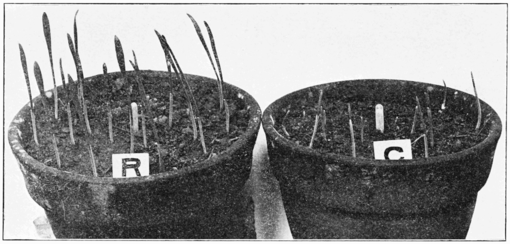example, the total growth in 24 hours was, for the exposed radicles, 28.66 mm., and for the control radicles only 16.08 mm.
Thus it is seen that exposure to radium rays, though followed in some cases by a retardation or inhibition of function may, under certain suitable conditions of exposure and with certain tissues, be followed by an acceleration.
Excitation of function is further illustrated by the following experiment: In a flower pot of soil unsoaked seeds of oat were sown in three concentric circles, distant, respectively, 7 mm., 22 mm. and 45 mm. from the center of the pot. Into the soil at the center was inserted the sealed glass tube of radium bromide of 1,500,000 activity. The end containing the radium was about 15 mm. below the soil surface. A second pot was arranged in a like manner except for the substitution of an empty glass tube for the radium tube. At the end of 106 hours the seedlings from the exposed seeds were much taller
than those in the control pot (Fig. 7), the amount of stimulation being greatest in the outer circle of plants and least in the inner circle. At the end of the 106-hour period the radium tube was placed in the control pot and the empty glass tube in the pot R. Following this change the seedlings in CR grew faster than those in R, now serving as a control. Thus it was possible to accelerate the growth of the seedlings in either pot at will by transferring the radium tube from one culture to the other.
The fact that incandescent gas mantles contain a large percentage of thorium, a radioactive substance, suggested the following experiment. On the surface of soil in a pot was sown a row of timothy grass seed, and over this row and at right angles to it, was suspended a fresh, unburned mantle at a distance of three or four millimeters above the seeds (Fig. 8). Germination and subsequent growth were both retarded


